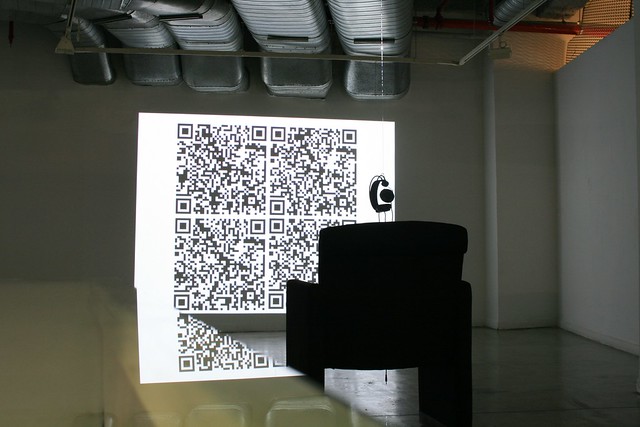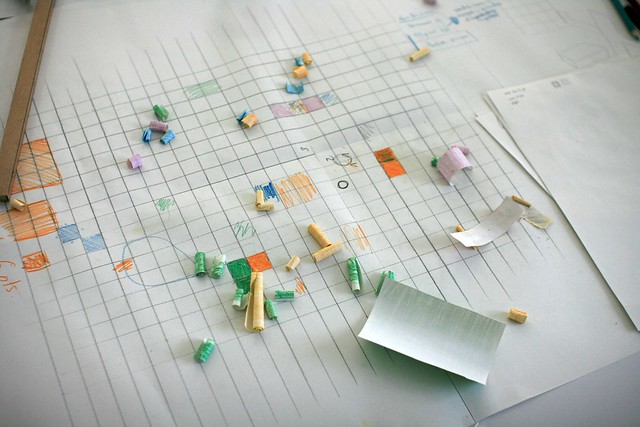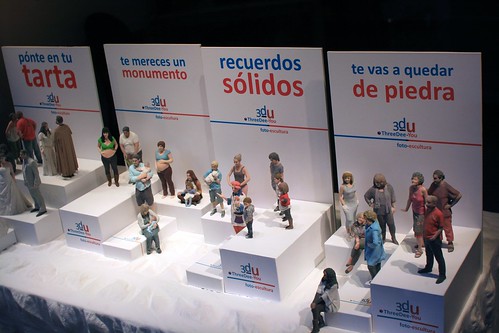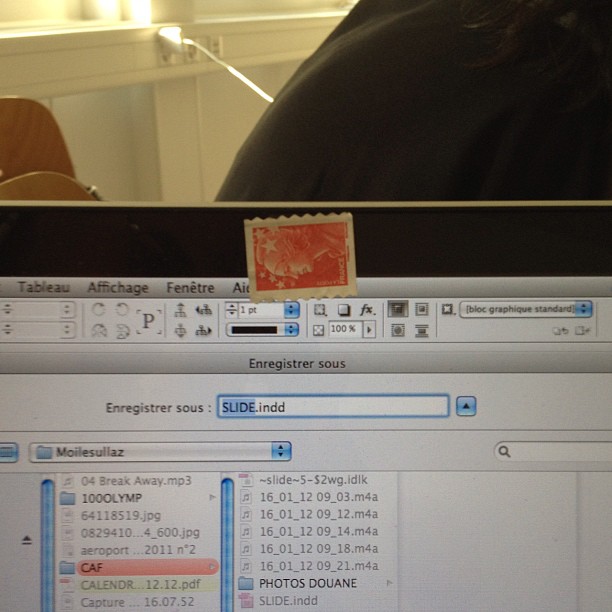Once in a while, I enjoy conducting interviews with the interesting people I encounter in my work. This time, I discussed with Ulrich Fischer, founder of Walking the Edit, a very intriguing locative media application that allows users to “walk a movie” : your recorded walk will be translated into a movie through our iPhone app'.


Nicolas: Can you describe what "Walking the Edit" is and how you came up with this idea?
Ulrich: Walking the Edit is a mobile application that empowers the user to compose a unique and surprising movie based on existing audiovisual fragments, through the act of walking. It works the following way: The user generates his movie with the help of an iPhone app that translates in real time the form of his or her path into a narrative playlist of previously geolocalized media files. First comes the active experience where the user (walker) hears the sound of the movie (walk and listen), then comes the reception where it is possible to watch the resulting personal movie (watch and listen).
Stories of-from-about-with the territory: the practice of "walking of a movie" is an open and playful way of interacting with the audiovisual memory of our surrounding environment and everyday life. By mixing our immediate reality with feeds and data coming from the digital space (the mobile internet), we create a so-called "augmented reality". The project "Walking the Edit" opens an alternative path to this hybrid territory, by reducing the data-worlds into an artificial construction that is a story-line. One story out of many potential others: the past of the place you are interacting with is (re)combining itself to deliver a new, contextual and unique story that belongs to your present.
This concept is based on following thoughts, desires and intuitions:
- The importance of the database (and by extension, of the metadata). On the road of creating an artistic/knowledge object (a movie, a text, photographies etc), there always exists a place filled with material that becomes both the fuel and the horizon of the messages and stories we create. In order to deliver a message, we reduce the complexity of this place by filtering / cleaning it down to a singular and specific object that we can present and share with the public. Nowadays, this place is called a "database"; a few years ago, we where speaking about the editing bin or the atelier. We still have the working place (that can be called atelier) but we also interact with this virtual place filled with digital content. Basically (I'm not considering creativity yet), the concern is storage, accessibility and usability – but what differentiates the virtual place (our database) from the real place (our atelier) is that the limitations and possibilities of the database are very different from the atelier. Let me give two examples: the database has a priori no time and space limit, the outputs of the database can be multiple and infinite. Even if this seems obvious technically speaking, we still use the database as if we where working in our atelier. What comes out of our atelier is a single object (say, a movie of 90 minutes), and after that, the atelier is not used anymore (the rushes are left in the dust). In order to make another movie, we build up another atelier, and so on. In other words, we use the digital space as if it was only the extension (or a copy/paste) of our physical space – and we miss the main point. For me, the main point is to consider every asset as a unique form that can live it's own life, outside of the projects and objects we, as authors, want to place them in. Why does this picture, this sequence have to be used only in this particular way in that specific movie ? Why do we present only a little percentage of our content, even if a lot more can be of interest to some people? There are many open questions (that will certainly lead to many different answers that will change over time), but one thing is certain: data without metadata will hardly survive. The value does not lie in the created object itself, but in the use (evolution, experience, transmission) of it. And without metadata, there is no use (at least in the digital world). The project "Walking the Edit" tries to use those metadata with an artistic approach: by linking data together, based on words, concepts and values. In a way, the project can be seen as metadata driven storytelling.
- The author – spectator relation. This is not something new to the digital age, but every person is sometimes active (creating something) and sometimes passive (being a spectator). For many reasons (derived from the available tools and techniques, from the economic system etc), the world we come from is focused on a strong separation of both attitudes. Copyright, Intellectual Property on one hand and costs on the other helped to make the revenue streams easy and protected for some happy few. Now that the hardware industry (but software is not so far away either…) made it possible to use a very common gadget like a smartphone to create, edit and share content (and this is only one example), the vertical relationship between the author (on the top) and the spectators (on the bottom) is loosing it's balance to become more horizontal. But even if the walls disappeared, this will not mean that there will be a tsunami of new creators who will take the resources, ideas and place of the existing ones. Creation is still a painful and long road that not many are willing to go through. The chance we have today is that it is possible to decide in a very adaptive and evolving way, for each project individually, the relationship between those who give and those who take. Given that those who take might want to give the object / experience further to another person, a chain reaction is created, that is not only virtual, but real (based on exchanged data). In a way, it is like creating a discussion, where somebody is the host, takes care of the ambiance, the scenography, the storyworld, and invites people to discuss, interact, create within this space that does not have to fit the rules of our "first world". What is basically different here, is that we are not in mass media anymore (like TV or cinema), because the value created is not based on the main story of the "one to many" but on the specific story (stories) of the "one to one", or even of the "many to one". Finally, what counts is not who has the "final cut" (who is the author in the classical sense), but how it is possible to let each individual create his or her own personal relationship to your content (from a very active attitude to a passive position) - and to open up the appetite to come back, to bring others in...
- Images are not limited by screens and closed forms (like movies, exhibition rooms etc). For me, the main issue of bringing images to life (by sharing them with another person) is not the resolution and the technical capacities of the viewing system but how we use the underlying technology (the medium). In fact, it is simple: there are linear and non linear devices. If the content is on a tape or film (linear medium), the use is dictated by time: there, definition and protection from the outside context does matter (cinema has a huge screen and big walls). Of course, there are some variations (DVD's in installation mode as an example), but basically, the issue is the same. Everything is decided and mastered in advance, the object is given and closed. Now, if we take the non linear devices (as computers are from the ground up), we could play a linear movie as we could navigate in a open and random way on the web. The fact that we use computers (and more and more mobile computers like smartphones and tablets) to play linear content is a heritage that will not vanish – but questions the quality of immersion in a given story or universe. Watching "Avatar" on an iPhone (or even an iPad) is not the same as seeing it in a movie theater; still, many people do it that way, but they do it often in a multitasking mode. The movie is "embedded" in and interacts with a given context (a train travel, a conversion on a chat), so there are potential new links created between the linear content and the open and non predictable outside world. One could ask the question if the final result is not an addition of two things, but more a subtraction, where the two scales (the outside complex reality and the linear artificial experience) are not compatible and competing one against the other. Personally, I'm very skeptical about today's trend to deliver the same content on every device, regardless of the context and the human need to embrace and re-appropriate his living ground (that the digital datasets are part of). For me, it is important to let each user decide of his own use of the digital world within space (scale, distance and speed) and time (duration, rhythm and dynamic), with the ability to manage the storage (his memory) by turning on or off the record function (read, or read/write).

Nicolas: With such a technology, the role of movie/documentary directors and producers shift a little. This may of course worry them but there's a lot to gain. How would you describe the possibilities?
Ulrich: What changes, is the power balance between content producers (may they be small authors or big companies) and the spectator, as described above. Cinema production was always a teamwork, but now in the team there can be active spectators (who get involved in the project over crowdfunding strategies for example). The question is what place will those newcomers inherit ? How is it possible to manage a growing community through the whole process of the project, without loosing the overall vision?
As for the fears that come up with those changes (they are basically not the same in the EU as in the US, based on the differences in the financing system), they are mainly economic (for the little players remains the question of how to finance the creative work and for the big players the question of who will get the main part of the new revenue streams.) but also artistic (loosing the symbolic of the "final cut", how to face and appropriate the new technological and conceptual possibilities?). Cinema took about 20 years to "deliver" itself from the theater (see the koulechov experiment). How long will it take for the cinema to deliver itself from old habits and recipes that come from a period that is over? Today's cameras are not video or cinema cameras anymore, but little computers with one eye and two ears (and many other sensors); the whole workflow is file based, we are working in a system that is completely non linear. Nevertheless the whole industry is acting as if the produced material was still on celluloid and artificially backing frontiers and limitations within the distribution process. The "tragic" story of the music industry is still in the minds, there could be a lot to loose if nothing is done. Transmedia projects, connected and smart TV's, social TV and so on: there are a lot of things in the air, and the air is hot and buzzy. The crucial issue, dramatically speaking, is the following: either internet can be managed (in the way TV stations manage their content and their audiences in the broadcasting world), or it's the end of TV stations as we know them. Le roi est mort, vive le roi!
And concerning what there is to be gained from the spectator's point of view, more or less everybody sings the same tune (but the roads that lead there can be very different):
- user engagement (based on interaction possibilities, the spectator gets to an emotional connection to a brand, a story universe)
- content dissemination and distribution by the users through their own network (they make free publicity of a product)
- content creation from the user (on the model of Facebook, where the value is created by the users)
Seen from the perspective of the big players, those goals can appear cynical (the users taken for salad); but from the perspective of the creators, the same mechanism can lead to open imagination, stimulate intellectual curiosity, invite emotions to come up, etc. Putting them in opposition is an extreme simplification – in fact, what happens in reality is far more complex, because strategical choices (visible through marketing) are now embedded within the narration strategies. Form and content are jointly telling choral stories, the virus of marketing has eaten itself through to the ADN of the content.
The actual technological innovations that influence the creative possibilities are following:
- collaborative teamwork taken a step further (with a lot of questions to resolve), no limits in space and time
- open forms and hybrid mutants, that change over time (what you see is not what you got before)
- exploring new territories and imagining new rules, playgrounds and communities (sometimes the whole web 2.0 looks like the far-west with the promise of a new society)
And last but not least, for the documents themselves (if we "think" one second from their perspective): the promise of multiple comebacks, surprising coming-outs, "organic" combinatoric, chain reactions etc… Images have still a lot to say (outside of the movies where they are backed in).
Nicolas: What does it means in terms of narrative and scenario writing? How can you plan for a certain level of coherence and control (that directors may be unwilling to give up)?
Ulrich: The question of control often comes back, especially for specialists. May they be artists, intellectuals, scientists: their professional credit would be at risk if they loose control of the process and the result. What comes up now in addition to the control of the creation process and result, is the question of controlling the way a user comes into interaction with your content – in other words: how would it be possible to master or control the user ? What may seem like a coup d'état, is in fact the same will pushed a step further: you (should) know what is good for your audience (or somebody has to decide on the kind of content that will reach a particular group of people). The range is obviously very broad from large liberties within a framed coherence to a guided behavior within a reduced liberty. For the end user, the control question is less important.
What counts more is the facility of use, the immediate value that comes out of the use, and of course the fun and entertainment linked to the experience. But when a user feels that he is being manipulated and that the promised freedom is fake, it can break the relationship based on trust. The balance between the necessary control from the authors and the desired liberty for the users is very difficult to get right. The good news, is that today we can fine tune over time and tailor this balance for each specific user – but only if we shift the control and mastering focus a little bit.
Ideally, the main focus should be on the starting points, the paths and not only on the end results; the attention should be on each little "content brick" (taking it as an independent piece) and the whole system (establishing a cartography of the content and the mechanics of the logic that will filter the content). We are coming from a practice where those content bricks only matter when they are visible within a controlled object (a movie, a song, a text etc), which in turn is more important than the control over the whole project. In short, we use to focus a lot on manufactured objects (the goal) and not on the project (the road); if we change to focus on the project, then we should be able to produce objects that are not only presenting the destination, but share moments and situations of the path. So it is not replacing one thing with another (cinema is out, mashup movies is in), but "simply" adding new values, new objects to the existing ones.
As the creator is not alone anymore (but in an open conversation with other creators, with his audience and users), he has to share his choices and inform others within the creation process. It can be done in multiple ways, but when dealing with digital data, it comes down to describe the data and answering the main questions (who, how, why, when, where etc). This moment, which is technically not very difficult, is emotionally challenging: the author has to show his cards, share information, and, in a way, share power. It is the price to pay to build up new relationships between the content producer and the content user, where the common goal is to find a viable balance and cycles between giving and taking, manipulation and liberty, reading and writing.

Nicolas: A big chunk of the movie industry is somewhat focused on photorealism and 3D, I find that your project offer an orthogonal way to innovate. Can you tell us more about how the role of meta-data (such as location coordinates) in content production?
Ulrich: In a way, the basic question that drives industrial innovation is: how can we sell (again, more) ? 3D is perfect to invite, persuade and force the end user to buy a new TV set, and as there is not enough 3D content around, there is a big pressure on content producers to deliver their new production in 3D (on the way they have to invest a lot of money to make quality 3D).
The move of the industry towards 3D and high-definition comes not from the content producers, but from the hardware manufacturers like Sony, Panasonic etc. I see it a bit like the last dance of the dinosaurs before the comet of software ends up hitting our planet: the impact may seem slow from our point of view, but looking from a bigger perspective (from the dinosaurs perspective), it's happening very fast. The survival formula is perhaps not "grow and grow, get bigger and eat the other big ones to be the master" anymore; but instead "connect, link, eat and digest the data of others to become essential". We still have to use hardware, but now with a smartphone / tablet we have enough hardware power in our pocket to manage the biggest part of our digital life. The connectors that "drive" the Human-Computer interactions are not those cables that we have to sort out anymore (where is my HDMI-DVI adapter ?) but the software bridges (can I talk with your API ?). In a way, it's good news: we can finally come (back) to the manipulation and interaction with the content, all together. The digital space is not (only) a technological firework, full of spectacular forces (like 3D) and serving our need of mastering our own life (how to go as fast as possible from point A to point B, getting the cheapest restaurant on the way), but it is like life itself: complex, living it's own unpredictable life, becoming what driving forces in humanity plant within it.
Metadata are not as sexy to talk about as 3D, there is nothing to sell directly (data and metadata have no value per se, only their use makes them valuable). People know that metadata are very important, but the road to produce quality metadata is very boring: you have to tell the machine what you know about the data ("All about Data"); also, you can simulate some results, but it's only a preview of one state among many others. For the moment, the main usage of metadata is the control of the data (ah, the control again): find, filter and monetize are the core functions and uses of metadata. But we forget an important part of metadata by reducing them to this objective and functional role: metadata can tell stories (about the data they belong to, but also between datasets). Stories are subjective, that's not very 01, that's human, but hey, who build up those incredible calculators ? Humans need images and stories to frame the complexity of our world, giving a small illusion that we understand it.
Nicolas: Thanks a lot Ulrich for the very detailed answers!
![]()


 Seen in Madrid last week.
Seen in Madrid last week.

 Observed on one of my student's laptop. He told me that he "did not want to be observed" (nor he wanted his laptop to be controlled from elsewhere). Which is why he he put a (French) stamp ("easy to remove", he told me) on the camera.
Observed on one of my student's laptop. He told me that he "did not want to be observed" (nor he wanted his laptop to be controlled from elsewhere). Which is why he he put a (French) stamp ("easy to remove", he told me) on the camera.





 A fascinating interface design seen yesterday in Lausanne. Although the aesthetical quality of this is a bit weird, I am fascinated by the way the physical metaphor is employed here.
A fascinating interface design seen yesterday in Lausanne. Although the aesthetical quality of this is a bit weird, I am fascinated by the way the physical metaphor is employed here.